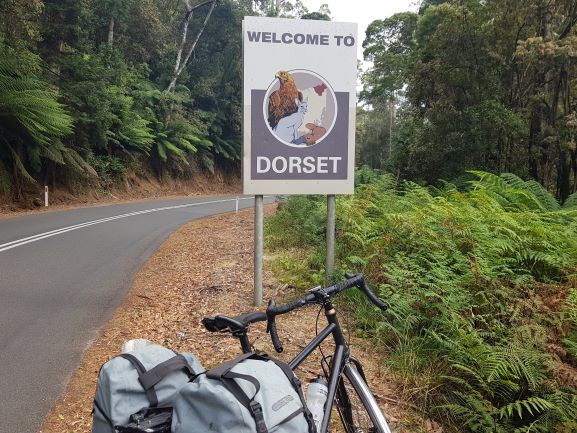 |
On the Why How and Downloads You can download the parts of the route we cycled. It needs to be unzipped and saved to a directory of your choice. You can then load it into the appropriate applications and GPS.
The Blog
St Helens to Weldborough 3rd February 2019
We left our happy motel keeper quite early for us. The weather forecast, for the third time since we have been in Tasmania, gave wind storms with temperatures over 30 degrees and winds of 30kmph. The wind was also from the north, the direction we were heading.On the plus side the strongest wind does not start blowing until midday. But on the down side we would have to cycle during the afternoon. The ride was too hilly for the stoker to guarantee making it without a battery charge which would take about 90 minutes.
As usual the management had a plan, he always does. We would cycle on to about halfway, at a place called Pyengana where there is a road house. Here we would have an early lunch while the battery charged.
It was a delightful ride. We were now properly back in the north, the traffic was light and the pastures were intermingled with forest. Of course it was a long way from flat but it was a real pleasure to cycle the easy gradients in a low gear. It was also of course fun to whoosh down now and again.
Just before lunch the management again had his path crossed by a short-beaked echidna or “maybe hedgehog”. He jumped off to take a picture but on seeing him the maybe hedgehog turned into a ball in the middle of the road. Before a car came and he had to do something the canny animal scuttled off but not before some good pics were taken.
The management feels pretty lucky as the only other place he has seen them is on the David Attenborough programme on TV. So maybe “maybe hedgehogs” are not that common.
Soon after this we reached the road house for lunch and at this point the management's judgement left him. But he was saved by divine intervention.
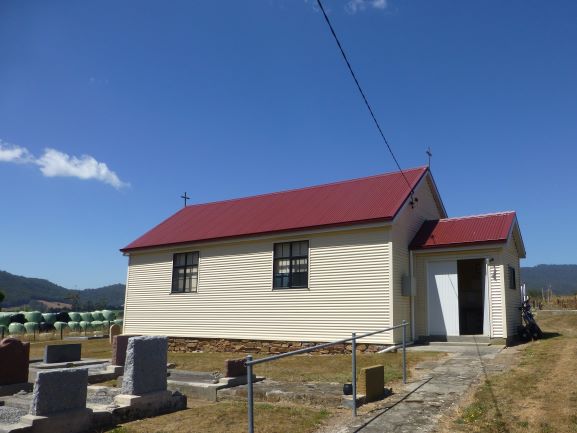 |
Remote church where we charged the battery
The road house now shuts on Sundays. We searched high and low outside but there was no conveniently placed 13amp socket for the stoker's charger. There was a possible alternative place to eat and charge but it involved a 4km detour.
Now anyone in his right mind would have made this detour. The only alternative would have been for the stoker to walk with a flat battery for further than the average footslog. So much too far. But the management decided to go on.
After about a km we came to a corrugated iron chapel with its own tiny graveyard. It looked locked but we thought we would give it a try. Not only was it open but visitors were welcome and there were even chairs to take outside and sit on.
We plugged in the battery and had lunch from what we had in the panniers. One pannier is almost always at least half full of food. 90 minutes later, having left a thank you in the visitors' book, we were on our way with an almost full battery and well fed.
On reflection the great cyclist in the sky, in churches in many countries and of many persuasions including mosques and temples, has looked after us cyclists in need. S/he has given us shelter for our lunch on numerous occasions, filled our water bottles and provided toilet and washing facilities. Sometimes if we have been especially good she has provided us with tea and cakes. But this was the first time for a battery charge.
Fed, watered and charged we headed onwards and upwards on a very serious steep climb in over 30 degrees over the Weldborough Pass. Some of the road was so steep that the management, who had been long dropped by the stoker, had to walk.
We were a very tired pair when we arrived at the Weldborough Hotel. It is a pub with rooms and a camp site and very ethnic. When we arrived there was a heavy folk band playing but we just had to crash out for a couple of hours.
Weldborough is a small village now but in the late 1800s and early 1900s it was a thriving 24 hour round the clock tin mining town. Chinese miners outnumbered the Europeans and there were more than 1000 of them. Apart from hotels and pubs there was a Chinese run casino and allegedly an opium den. The buildings remain and are across the road from the hotel which was rebuilt in 1928 after a fire.
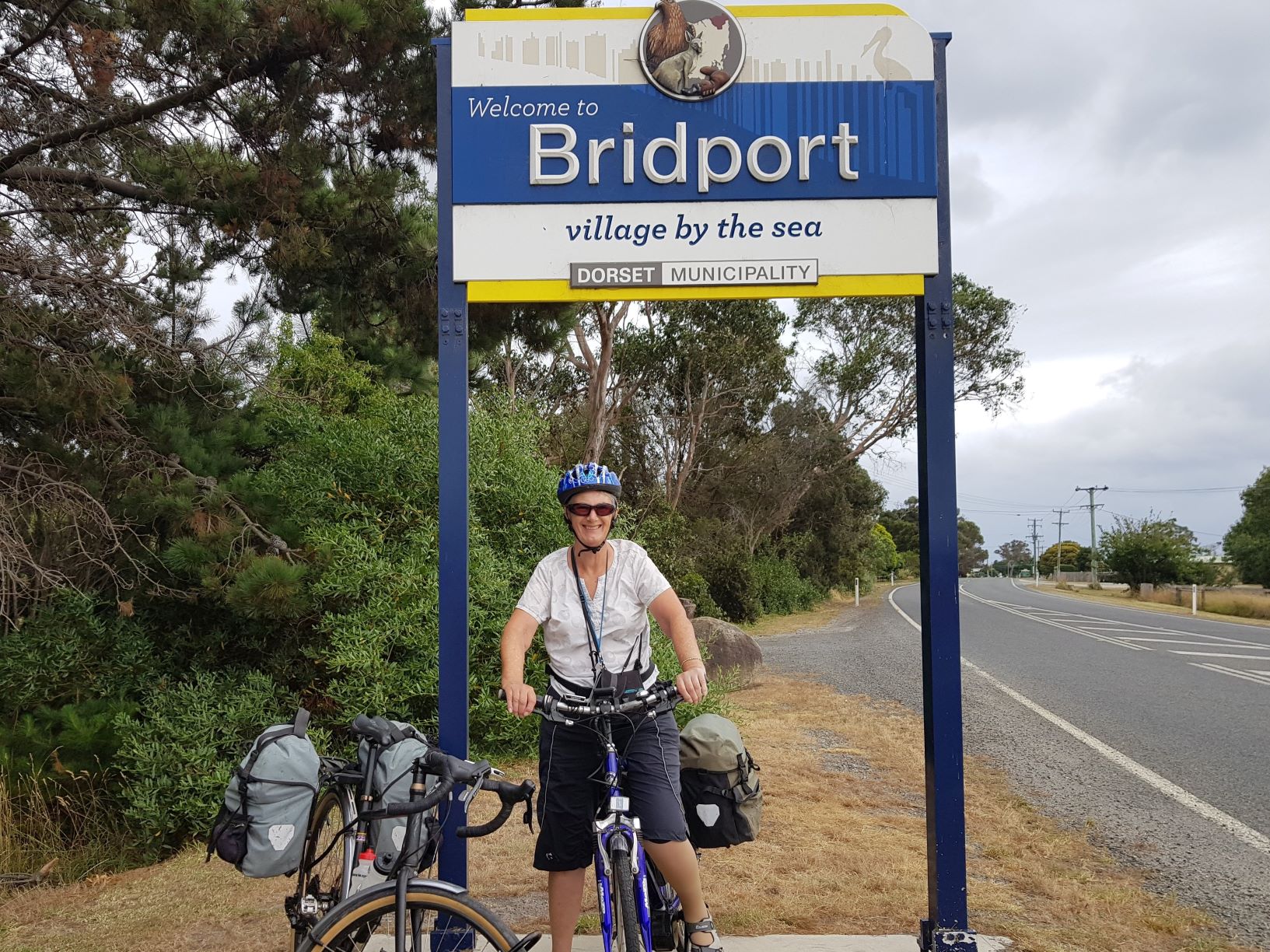 |
Bridport Tasmania
Weldborough to Bridport 4th - 5th February 2019
Mr Garmin Connect is pretty good at doing routes but he is not perfect in Tasmania. His great eye in the sky does not seem able to distinguish between a gravel road and a tarmac road. Neither does Tasmanian road numbering, C roads can be either.
The stoker does not mind a short stretch of fairly level gravel road, especially if it is going somewhere she would like to be. Today's route started on a gravel road opposite the hotel and the up gradient not only looked steep but the Garmin profile showed that it was steep.
The Weldborough Hotel and camp site is used a lot by serious mountain bikers so we consulted the landlord. The vast majority of people who offer us advice don't have the slightest clue what they are talking about. This guy said “It's not suitable for road bikes and you would be better off doing an extra 10km to avoid it, also there are logging trucks up there”. No nonsense and to the point, he clearly knew what he was talking about and the management took his advice.
So a long ride for us became even longer. The new route went down into a valley and back up instead of over the top of a mountain and down the other side on the gravel road. It was also one of the prettiest rides we have had in Tasmania and, co-incidentally, took us into the Municipality of Dorset. The road descended for 10km through winding gorges and through the rain forest. The road was often edged with huge ferns and the trees towered into the sky.
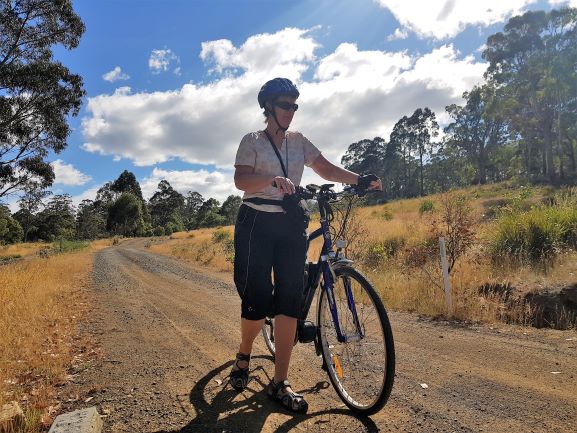 |
Lots of cycling on gravel roads
After a short climb and another rapid descent we came to the village of Derby which has been completely taken over by mountain bikers. There is a cats cradle of mountain bike trails on the map, several hire shops and it looks as if uplifts are available, They have realised in this Dorset something that the real Dorset and England have missed, that we cyclists can be big business, but only if proper facilities are provided.
We then had a gradual climb back up to the other end of the gravel road. Soon after this we settled into a nice little café, put the battery on charge and had an early lunch. The battery was a long way from exhausted but Mr Garmin had told us that there was a lot more climbing to come and he was not wrong,
The ride in the afternoon was not especially inspiring but it could have been. At Scottsdale there is about 30km of rail trail and for us it would have been descending most of the way. There were gates, explanation boards and it would have all been wonderful if they had just bothered to run a tarmac machine along it.
Routes like this are a complete waste of money and will only be used by serious mountain bikers. Sustrans are of course the worst at surfaces but even the French have done as badly in some places. If you want to get families, especially children, riding bikes you have to have a tarmac surface. Mud, clay, gravel or anything else these botchers come up with just won't do. You can't ride a bike on it properly.
The road became busier towards Bridport and we were both very weary and pleased to arrive. We had climbed around 2000m in two days and the stoker and her battery had both stood up well. The management's legs were looking forward to a rest. On the whole the battery had done the better job but then it was younger.
Bridport Tasmania is a pretty place and quite unlike its namesake in Dorset. It is by the sea with sandy beaches and a deep tidal estuary with white sand when the tide is out. The hostel overlooks the estuary and the hills beyond. We booked a hostel by mistake, we don't do hostels on purpose these days, but it is not bad, just not what we have become used to.
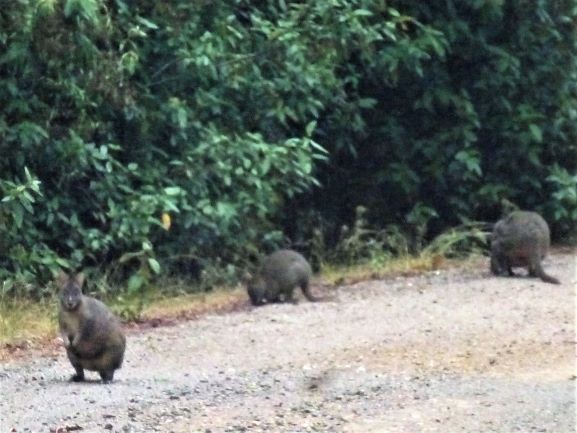 |
Wallabies crossed our remote gravel road
Bridport to Red Rooster 6th February 2019
Bridport was a very pleasant place but the clouds were heavy. One hostel guest, not the cleverest, said to us without irony “nice day for a cycle ride”. The management was polite, just.
The management had planned over half of today's ride on gravel roads. So far we have mostly avoided them but he felt we should at least give them a try. The stoker was not so sure. Her bike has narrower tyres than that of the management and she does not have his mountain bike experience.
The management was lucky because the start of the gravel road was actually tarmac. By the time it turned to gravel it would have meant a retrace which as our friends know is unacceptable.
The surface was not that bad. The stoker worked out which bits to ride on and which to avoid and with the aid of electricity she was soon well ahead of the management. And it was really lovely to be in remote forests and farm land, silent except for wild life.
People do live in these remote places, some in opulent luxury and others in apparent squalor and mainly a long way from each other. They certainly need to be self sufficient and avoid old age and snake bites. Although one could solve the problem of the other.
There were actually a couple of cars and also two timber lorries but they were considerate as were we. We are not sure how sustainable the timber industry is here but it is a big and very disruptive business. It is made worse because Tasmania has closed down its fairly extensive rail network almost completely.
The holiday cottage we had booked for the night was 5km up a second gravel track. On our map the track petered out before we got to the cottage. By now there was light rain and the route was not the most attractive or inviting. The surface was quite loose and the valley it ran through was boggy with scrubby trees.
The cottage on a hobby farm was pleasant, though the management was a bit put off by the constant mention of snakes. There are three species of snakes here and all of them are venomous. It is perfectly reasonable to want to stay somewhere where they aren't.
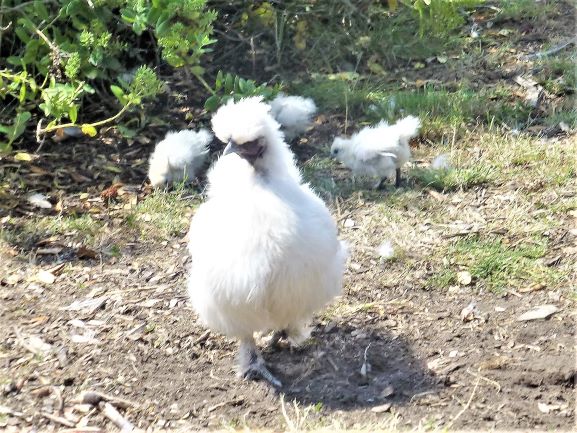 |
Chooks at our welcome coffee stop
Red Rooster to Hazel Creek near Exeter 7th February 2019
We try never to retrace and the unmapped track we came onto continued onwards into the forest as did we. After about a km we came to a track junction with a scrappy sign pointing us in the right direction. As that direction was also steeply up hill, as all cyclists know, we could not go wrong. Cyclists never go down when lost.
It felt quite adventurous taking this unmapped track. It was very rough and wound up the hill with the usual hairpin bends. It was misty and warm with high humidity. We came across a sign which said it was “Snake Track”. Most likely because it twisted and turned every which way. But it was hard to ignore yet another reference to snakes. The stoker's path was crossed by wallabies, everything was a bit spooky.
We cheered when we finally came out onto tarmac roads but we still had a long way to go. Until early afternoon, when the sun came out, we followed several deserted country roads through farm land. As usual there was no sign, or even a reasonable chance, of finding a coffee stop.
But amazingly we came across picnic tables and a BBQ area for late lunch. They appeared to be in the middle of nowhere. But we were near the site of a semaphore relay station above the Tamar river. It was not the waving flags sort but shapes on a tall tower. It alerted the population of the arrival of ships in the days before telegraph or radio.
We then continued on a picturesque route beside the wide Tamar, north and over the Batman Bridge and south again down the other side to Exeter. All was fine except that the stoker ran out of electricity. But on the good side we were almost at the only coffee shop we had seen all day.
The battery charged for an hour saw her to the farm stay we had booked just outside Exeter. Meanwhile the management stopped off at the supermarket to get supplies. He was also surprised to see a wallaby cross the road in front of him from one urban garden to another.
The stoker needed electricity, we had climbed 975m and around a third of it was off road. We count on being able to climb 800m on typical Tasmanian roads.
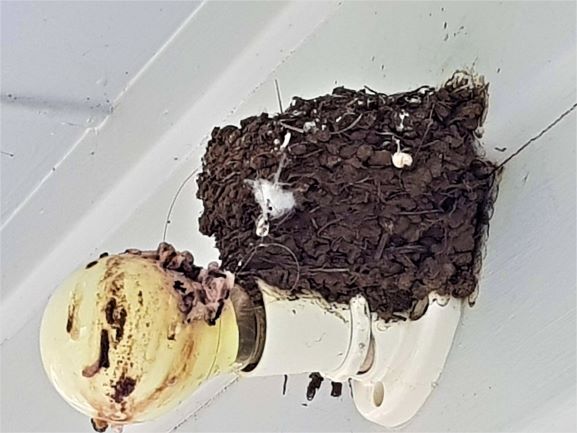 |
Empty swallows nest, they have fledged
Hazel Creek near Exeter to Sassafras 8th February 2019
This was the last long ride of our tour of Tasmania and we were feeling pleased with ourselves as we pedalled out in the sunshine. But a tour is not over until it is over and so it proved today.
Getting nearer to Devonport we had not expected quiet roads but for the first hour or so there was little traffic. But all too soon we joined the Fairford Highway which was busy with commercial traffic including timber lorries.
The traffic was especially daunting because we had a very strong head wind. On the plus side there was a café along the way which had rather nice carrot cake.
Despite the headwind the management was confident that the stoker's battery would hold out. Garmin Connect said that the route involved 630m of climb. It turned out to be 850m of climb.
We were only about 3km short of Sassafras when the battery ran out but the stoker was very tired and very fed up. But given tea and late lunch she soon recovered. Part 7 below Sassafras to Devonport 9th February 2019
We saw sea eagles circling above the lakes on our farm stay last night. We also saw them near Exeter, it is a real pleasure to see such a large and lovely bird soaring among the clouds.
The short ride today was not such a pleasure. The only way into Devonport from here was on the roaring Bass Highway which is hardly to be recommended for human beings let alone cyclists. We did six km on the narrow and dangerous hard shoulder in a little under 20 minutes. After that the rest of the ride in, mainly on busy roads, seemed easy.
It was with a great feeling of satisfaction and pleasure that we completed our ride with a celebratory lunch overlooking the Mersey river. We had a hail storm while we were eating but, like most of this tour, avoided riding in the rain. We then returned to the best self catering apartment in Tasmania to prepare for our long journey home.
Having completed our circle of Tasmania the return home will be the reverse of getting here. We will get the “Spirit of Tasmania” overnight to Melbourne and spend a few days in the Melbourne area, including a train and bus journey along the Great Ocean Road. We will then get the train back to Sydney, spend a few more days with the family and fly home via Hong Kong. By spending some time in Sydney and Hong Kong we will be back in real Dorset in early March ready for the spring.
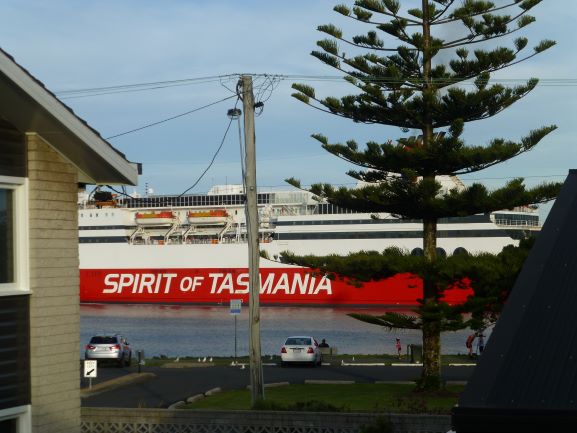 |
Back to mainland Australia